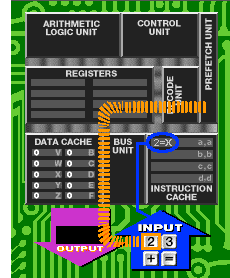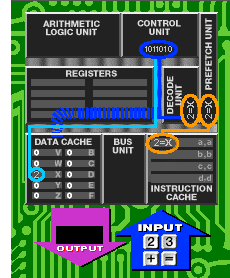Pressing the 2 key alerts the microprocessor and signals the Prefetch Unit to ask the computer's main memory for a specific instruction on the new data since there is nothing about it in the Instruction Cache. The new data instruction comes into the microprocessor through the Bus Unit from the computer's main memory and gets stored in the Instruction Cache, where it is assigned a code "2=X". The Prefetch Unit then asks the Instruction Cache for a copy of the code "2=X" and sends it to the Decode Unit for further processing. In the Decode Unit the instruction "2=X" is translated or decoded into a string of binary code that is sent off to the Control Unit and the Data Cache to tell them what to do with the instruction. Because the Decode Unit figured out that the number 2 was to be stored for the future in the Data Cache, the Control Unit now performs the instruction for "2=X." This causes the number 2 to be sent to an address in the Data Cache called "X," where you see it waiting for further orders. |
  |